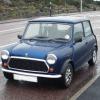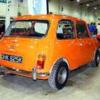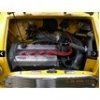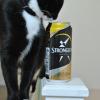Hi I was wondering if anyone has any experience with using water heated inlet manifold. I have run one before but not had it plumbed in for the heated water. If anyone could explain the science behind these and the advantages and or disadvantages that would be great. any explaination of setup or pictures of setup etc would be great. thanks a lot.

Water Heated Alloy Inlet Manifold
#1

Posted 21 January 2014 - 05:07 PM
#2

Posted 21 January 2014 - 05:08 PM
Water cooled I think
#3

Posted 21 January 2014 - 05:31 PM
#4

Posted 21 January 2014 - 05:55 PM
The water heating is supposed to help with icing up in the winter - basically it's when the inlet temp falls so low ice crystals form. On a normal mini with a cast iron inlet and exhaust the heat from the exhaust prevents this.
Some people connect it, some people don't - the manifold sits on top of the exhaust manifold, so some latent heat gets sucked into the inlet manifold anyway. I think if you live in a very cold climate then it's probably a good suggestion to connect it ... in UK it's maybe not that much of an issue.
#5

Posted 21 January 2014 - 05:56 PM
Hi
just a quick one
when it is plumed in the water starts to heat the inlet manifold quickly
pros
get you of choke quicker stops carb iceing
cons
the hotter the inlet charge is the less air
so you get less petrol in
#6

Posted 21 January 2014 - 05:57 PM
There is really very little point in connecting it up.
And before anyone says it, it is not to do with carb icing.
And yes, I'm sure it is for heating, not cooling.
#7

Posted 21 January 2014 - 05:57 PM
The idea was introduced to make the car run better in cold weather.
A lot of us just by-pass the water-heated manifold to ensure the inlet charge is as cool as possible as a cool charge will give more power at normal operating temps.
But others like the heated manifold, so it's personal choice.
All early Minis, including Cooper & Cooper 'S' didn't have heated manifolds and they went OK.
#8

Posted 21 January 2014 - 06:14 PM
If it's connected to the heater circuit, I suppose you can have it heated when it's cold and not heated when it's hot??
#9

Posted 21 January 2014 - 07:18 PM
I definitely didn't want mine http://www.theminifo...beautiful-swan/ ![]() The cooler the inlet charge the denser the charge is so more POWER
The cooler the inlet charge the denser the charge is so more POWER ![]()
#10

Posted 21 January 2014 - 07:26 PM
So in my opinion there is a point in connecting them up, but wether you'll actually gain any benefit depends on what you actually use your mini for. I have two 1275 minis, one with the inlet plumbed in and one with it not. Both cars behave very similarly in warm/mild weather conditions . The difference between the two is very noticeable on cold mornings though, with the plumbed in version running more smoothly, much more quickly, and requiring much less choke than the non plumbed in version does.
So if you're using your mini all year round as a daily drive, then I'd thoroughly recommend that you plumb your heated inlet in. Whereas if you 're only using it over the summer months, then I probably wouldn't bother, as you're unlikely to gain any benefit from doing so. If your mini is a highly tuned monster, or a track car that you're looking to squeeze every last ounce of performance out of, then you're likely to want your induction tempetature to be as cold as possible, so you probably won't want to plumb your heated inlet in either.
#11

Posted 21 January 2014 - 07:28 PM
I could never see the advantages, despite being told by various people that without a heated inlet I would get carb icing, poor cold running, bad mixture, etc.
I have never had on in over 50 years of building, driving, rallying and testing Minis.
Just think, a lot of engines have turbos with intercoolers to make the charge as cool as possible. say no more ![]() .
.
#12

Posted 21 January 2014 - 07:33 PM
thanks for all the input, very interesting so far.
#13

Posted 21 January 2014 - 07:46 PM
Carb icing up is no urban myth.
I had this happen to me on a '76 998 mini. This was using standard cast iron inlet manifold with standard single HS4 carb & BL filter. The trumpet on the air filter was in the 'summer position' at the time, taking cool air rather than warm air from near the exhaust manifold.
It was not a particularly cold day either, but was very damp. Not a pleasant experince when it happens - basically the throttle jammed open and then all you can do is either stamp on brakes or switch ignition off.
#14

Posted 21 January 2014 - 07:49 PM
Carb icing up is no urban myth.
I had this happen to me on a '76 998 mini. This was using standard cast iron inlet manifold with standard single HS4 carb & BL filter. The trumpet on the air filter was in the 'summer position' at the time, taking cool air rather than warm air from near the exhaust manifold.
It was not a particularly cold day either, but was very damp. Not a pleasant experince when it happens - basically the throttle jammed open and then all you can do is either stamp on brakes or switch ignition off.
It's not a myth, but a heated inlet manifold is not to prevent it icing.
#15

Posted 21 January 2014 - 09:50 PM
OK, for the benefit of the OP I will continue...
Following on from the icing up problems with my 1976 998, I made the following changes. In time honoured manner the cast iron inlet manifold was sawn off the exhaust manifold so I could continue to use the standard exhaust. The replacement inlet manifold was a small bore Oselli Torquemaster, keeping the HS4 carb with a bit of Vizarding to the internals, and with a K&N filter and stub-stack replacing the standard air filter box. No attempt made to pick up hot air from the exhaust. Inlet piped up to take permanent hot water bypass. Rest as before.
I never experienced any problems with carb icing on this set-up and this was used for several years as a daily driver in all weather conditions.
So in my (limited) experience, a water heated inlet manifold can prevent carb icing.
1 user(s) are reading this topic
0 members, 1 guests, 0 anonymous users




















